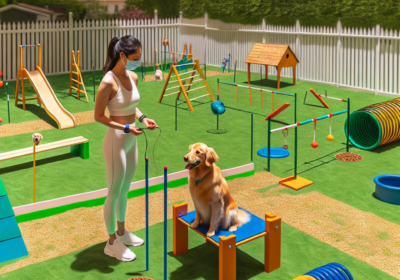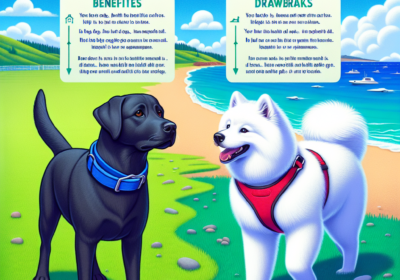The Benefits of Dog Walking and Training: Improving the Health and Happiness of Dogs and Their Owners
Explanation of the importance of dog walking and training for the overall health and happiness of dogs and their owners

Dog walking and training are essential for the overall health and happiness of both dogs and their owners. Dogs are social animals, and they need regular exercise, mental stimulation, and socialization to maintain their physical and mental well-being. Here are some reasons why dog walking and training are important:
- Exercise: Regular exercise is crucial for a dog’s physical health. Walking, running, playing, and swimming are all excellent ways to keep a dog fit and healthy. Lack of exercise can lead to obesity, which can cause health problems such as diabetes, joint problems, and heart disease.
- Mental Stimulation: Dogs need mental stimulation as much as physical exercise. Boredom can lead to destructive behavior, including chewing, digging, and excessive barking. Regular training and interactive play sessions can provide the mental stimulation that dogs need to stay happy and healthy.
- Socialization: Dogs are social animals, and they need to interact with other dogs and people to develop proper social skills. Regular walks and trips to the dog park can help dogs learn how to behave appropriately around other dogs and people. Proper socialization can prevent behavior problems and improve a dog’s overall quality of life.
- Bonding: Walking and training with your dog can strengthen the bond between you and your pet. Dogs are pack animals and thrive on social interaction with their human family members. Spending time with your dog and providing positive reinforcement through training and play can enhance the bond between you and your pet.
- Stress Relief: Walking and training with your dog can also help reduce stress levels in both you and your pet. Walking and exercising releases endorphins, which can improve your mood and reduce stress. In addition, training can help dogs learn how to cope with stress and anxiety in a positive way.
Brief overview of the benefits of dog walking and training
Dog walking and training are two essential activities that can benefit both dogs and their owners in many ways. Here’s a brief overview of the benefits of these activities:
- Physical exercise: Dog walking is a great way to provide dogs with the physical exercise they need to maintain good health. Regular walks can improve cardiovascular health, strengthen muscles and bones, and help manage weight. Exercise is also essential for preventing obesity, a common problem in dogs that can lead to various health issues.
- Mental stimulation: Dogs need mental stimulation as much as physical exercise. Training and interactive play sessions can provide the mental stimulation that dogs need to stay happy and healthy. Mental stimulation can prevent boredom, reduce stress and anxiety, and prevent behavioral problems such as excessive barking and destructive chewing.
- Socialization: Dogs are social animals and need to interact with other dogs and people to develop proper social skills. Regular walks and trips to the dog park can help dogs learn how to behave appropriately around other dogs and people. Proper socialization can prevent behavior problems and improve a dog’s overall quality of life.
- Bonding: Walking and training with your dog can strengthen the bond between you and your pet. Dogs are pack animals and thrive on social interaction with their human family members. Spending time with your dog and providing positive reinforcement through training and play can enhance the bond between you and your pet.
- Health benefits for owners: Dog walking and training can also provide health benefits for owners. Walking with your dog is a great form of exercise for people and can help reduce stress, lower blood pressure, and improve cardiovascular health. Training your dog can also be a fun and rewarding way to bond with your pet and reduce stress levels.
II. The Benefits of Dog Walking
- Physical benefits such as exercise, weight management, and improved cardiovascular health
Dog walking and physical activity provide numerous physical benefits for dogs. Here are some of the physical benefits of dog walking and physical activity:
- Exercise: Regular exercise is essential for maintaining good physical health in dogs. Walking is a low-impact form of exercise that can help dogs maintain healthy bones, muscles, and joints. Dogs that get regular exercise are less likely to become overweight, which can lead to various health problems such as heart disease, diabetes, and joint issues.
- Weight management: Obesity is a common problem in dogs, and it can lead to numerous health issues. Regular exercise, such as dog walking, can help dogs maintain a healthy weight. Weight management is important for preventing obesity and associated health problems, such as heart disease, respiratory problems, and diabetes.
- Improved cardiovascular health: Regular exercise, such as dog walking, can improve cardiovascular health in dogs. Exercise can strengthen the heart and improve blood circulation, leading to better cardiovascular health. Improved cardiovascular health can reduce the risk of heart disease and other related health issues.
- Strengthened muscles and bones: Regular exercise, such as dog walking, can help dogs maintain strong muscles and bones. Strong muscles and bones can prevent injuries, improve mobility, and help dogs maintain an active lifestyle.
- Reduced arthritis pain: Arthritis is a common condition in dogs, especially as they age. Regular exercise, such as dog walking, can help reduce arthritis pain by keeping the joints lubricated and improving overall joint health. Exercise can also help maintain healthy muscles and bones, reducing the risk of injury.
- Mental benefits such as stress relief, reduced anxiety, and improved mood
Dog walking and training can provide numerous mental benefits for both dogs and their owners. Here are some of the mental benefits of dog walking and training:
- Stress relief: Walking and playing with a dog can provide stress relief for both dogs and their owners. Spending time with a dog can reduce stress levels, lower blood pressure, and promote relaxation.
- Reduced anxiety: Dogs can suffer from anxiety, just like humans. Regular exercise, such as dog walking, can help reduce anxiety in dogs by providing mental stimulation and physical activity. Training can also help reduce anxiety by providing structure and routine.
- Improved mood: Spending time with a dog can improve mood and provide a sense of purpose and companionship. Walking with a dog can be a fun and enjoyable activity that provides a sense of accomplishment and satisfaction.
- Mental stimulation: Dogs need mental stimulation as much as physical exercise. Training and interactive play sessions can provide the mental stimulation that dogs need to stay happy and healthy. Mental stimulation can prevent boredom, reduce stress and anxiety, and prevent behavioral problems such as excessive barking and destructive chewing.
- Bonding: Spending time with a dog and providing positive reinforcement through training and play can enhance the bond between owners and their pets. Dogs are pack animals and thrive on social interaction with their human family members. Strengthening the bond with a dog can provide a sense of purpose and companionship, improving overall mental health and well-being.
- Social benefits such as socialization, exposure to new environments, and opportunities for social interaction
In addition to the physical and mental benefits, dog walking and training can provide numerous social benefits for both dogs and their owners. Here are some of the social benefits of dog walking and training:
- Socialization: Regular dog walking and training can help dogs become more comfortable and confident in social situations. Exposure to new people, dogs, and environments can help dogs learn to socialize in a safe and controlled environment.
- Exposure to new environments: Dogs that are regularly taken on walks are exposed to new environments, sights, sounds, and smells. This exposure can help dogs become more adaptable and better able to handle new situations.
- Opportunities for social interaction: Walking with a dog can provide opportunities for social interaction with other dog owners and dog lovers. This can help owners and their dogs to make new friends and expand their social circle.
- Improved behavior: Regular dog walking and training can help improve a dog’s behavior by providing structure and routine. Training can also help teach dogs appropriate behaviors, such as how to walk on a leash or how to greet other dogs.
- Enhanced quality of life: Dogs that are regularly walked and trained are generally happier and more fulfilled. They have a sense of purpose and a routine that helps keep them mentally and physically stimulated.
III. The Benefits of Dog Training
- Improved communication between dog and owner
Improved communication between a dog and its owner is one of the most significant benefits of dog walking and training. Here are some ways that dog walking and training can help improve communication between a dog and its owner:
- Nonverbal communication: Dogs primarily communicate through body language and nonverbal cues. By spending time walking and training with their dogs, owners can become more attuned to their dogs’ body language and behavior, and learn to interpret their dogs’ needs and desires.
- Obedience training: Obedience training can help dogs learn commands and signals from their owners, making it easier for the owner to communicate with their dog. When dogs understand what their owners want, they are more likely to behave appropriately and respond to their owner’s commands.
- Consistency: Consistent training and routines can help dogs understand what is expected of them and reduce confusion. By providing consistent cues and signals, owners can improve communication with their dogs and strengthen their bond.
- Positive reinforcement: Positive reinforcement training can help improve communication by rewarding desired behavior and encouraging dogs to repeat that behavior in the future. This can also help build trust between a dog and its owner, as dogs learn to associate their owner’s voice and actions with positive outcomes.
- Quality time: Spending time with a dog can help improve communication by building a stronger bond between the dog and its owner. Walking and training together can provide opportunities for positive reinforcement and bonding, leading to improved communication and understanding.
- Increased obedience and behavior management
Dog walking and training can be essential tools for managing a dog’s behavior and improving obedience. Here are some ways that dog walking and training can increase obedience and behavior management:
- Setting boundaries: Dogs thrive on structure and routine. Regular dog walking and training can help establish boundaries and teach dogs what is expected of them. By providing consistent cues and signals, owners can help their dogs understand what is appropriate behavior and what is not.
- Positive reinforcement: Positive reinforcement training, such as rewarding good behavior with treats or praise, can encourage dogs to repeat that behavior in the future. This can help improve obedience and behavior by teaching dogs that good behavior is rewarded.
- Addressing problem behavior: Dog walking and training can be an effective way to address problem behavior, such as jumping or pulling on the leash. By providing consistent training and correcting problem behavior, owners can help their dogs learn to behave appropriately in various situations.
- Socialization: Socialization is an essential part of managing a dog’s behavior. Dog walking and training can provide opportunities for socialization and exposure to new people, dogs, and environments. This can help dogs learn to behave appropriately in various situations and reduce problem behavior.
- Increased exercise: Dogs that receive regular exercise are often better behaved and easier to manage. Exercise helps release excess energy and reduce stress, leading to improved behavior and obedience.
- Mental stimulation and enrichment
Dog walking and training can provide essential mental stimulation and enrichment for dogs. Here are some ways that dog walking and training can help provide mental stimulation and enrichment:
- Exploration: Walking in new environments and exploring different scents and sights can be mentally stimulating for dogs. This can help prevent boredom and reduce destructive behavior caused by boredom.
- Training: Training exercises, such as obedience training and agility training, can be mentally stimulating for dogs. This can help keep their minds active and prevent boredom.
- Problem-solving: Interactive toys and puzzles can be a great way to provide mental stimulation for dogs. These toys can challenge dogs to solve problems and work for their food or treats.
- Socialization: Socializing with other dogs and people can be mentally stimulating for dogs. Meeting new dogs and people can help prevent boredom and reduce stress and anxiety.
- Bonding: Spending quality time with their owners can be mentally stimulating for dogs. This can help strengthen the bond between the dog and its owner and prevent boredom and separation anxiety.
- Increased confidence and independence for the dog
Dog walking and training can help increase a dog’s confidence and independence. Here are some ways that dog walking and training can improve a dog’s confidence and independence:
- Exposure to new environments: Walking in new environments can expose dogs to different sights, sounds, and smells, helping them become more comfortable in unfamiliar situations. This exposure can help build a dog’s confidence and independence.
- Problem-solving: Training exercises, such as puzzle toys and agility training, can help dogs develop problem-solving skills. This can help build a dog’s confidence and independence by teaching them to think for themselves.
- Socialization: Socializing with other dogs and people can help build a dog’s confidence and independence. Meeting new dogs and people can help them become more comfortable in different social situations.
- Off-leash time: Allowing dogs to have off-leash time in a safe, fenced area can help them build their independence and confidence. This allows them to explore and play in a safe environment, giving them the opportunity to gain confidence in their abilities.
- Positive reinforcement: Positive reinforcement training, such as rewarding good behavior with treats or praise, can help build a dog’s confidence and independence. By encouraging good behavior and rewarding their efforts, dogs can gain confidence in their abilities and become more independent.
IV. Combining Dog Walking and Training
- The synergistic benefits of combining dog walking and training
Combining dog walking and training can have synergistic benefits for both the dog and owner. Here are some ways that combining dog walking and training can benefit dogs and their owners:
- Improved physical and mental health: Dog walking provides physical exercise, while training exercises provide mental stimulation. Combining the two can provide a comprehensive workout for the dog’s physical and mental health, leading to improved overall well-being.
- Better obedience and behavior management: Training exercises can help improve obedience and behavior management, making dog walking safer and more enjoyable for both the dog and owner. This can help prevent problem behavior and reduce stress and frustration caused by disobedience.
- Increased communication and bonding: Training exercises require communication between the dog and owner, leading to improved communication and bonding. This can help strengthen the relationship between the dog and owner and improve the effectiveness of training.
- Increased socialization and exposure: Combining dog walking and training can provide opportunities for socialization and exposure to new environments. This can help dogs become more comfortable in different social situations and environments, leading to increased confidence and independence.
- Improved problem-solving skills: Training exercises require problem-solving skills, which can help dogs become better at thinking for themselves and solving problems. This can lead to increased confidence and independence, as well as better behavior management.
- Tips for incorporating training into daily walks
Incorporating training into daily walks can be an effective way to provide mental stimulation for dogs and improve their obedience and behavior management. Here are some tips for incorporating training into daily walks:
- Start small: Begin with simple exercises, such as sitting, staying, and walking on a loose leash. Gradually increase the difficulty of the exercises as your dog becomes more comfortable and proficient.
- Use positive reinforcement: Reward good behavior with treats, praise, or playtime. Positive reinforcement is an effective way to encourage good behavior and increase motivation.
- Be consistent: Use the same commands and rewards consistently. This will help your dog learn more quickly and avoid confusion.
- Use natural rewards: Use the environment around you as a reward, such as allowing your dog to sniff a tree or play with a toy after completing a task.
- Incorporate playtime: Incorporate playtime into training exercises to keep your dog motivated and engaged. Playing fetch or tug-of-war can be a fun way to incorporate training into your walk.
- Vary the exercises: Mix up the exercises to keep your dog mentally stimulated. This will prevent boredom and increase motivation.
- End on a positive note: End each training session on a positive note, such as with a successful command or a fun game of fetch. This will leave your dog feeling happy and motivated for the next session.
- How walking and training can strengthen the bond between dog and owner
Walking and training are both excellent ways to strengthen the bond between dogs and their owners. Here are some ways that walking and training can help to build a stronger bond between dogs and their owners:
- Spending quality time together: Walking and training both require one-on-one time with your dog, providing opportunities for you to bond and deepen your relationship. This time spent together can help increase trust, loyalty, and affection between you and your dog.
- Positive reinforcement: Using positive reinforcement during training, such as praise, treats, or play, can help build a positive association between you and your dog. This can create a stronger bond and increase your dog’s willingness to follow your commands.
- Communication: Effective communication is essential for successful training and walking. As you learn to communicate more effectively with your dog, you will develop a deeper understanding of each other’s needs and preferences, leading to a stronger bond.
- Shared experiences: Walking and training both provide shared experiences that can help to build a sense of companionship and shared purpose. These experiences can help to create positive memories and strengthen your bond.
- Learning together: Training and walking provide opportunities for both you and your dog to learn and grow together. This can create a sense of mutual respect and understanding, leading to a stronger bond.
- Increased affection: Regular walking and training can help to increase affection between you and your dog, as you both experience the positive benefits of spending time together.
V. The Importance of Finding a Qualified Dog Trainer
- The risks of improper training techniques or ineffective training
Improper training techniques or ineffective training can have negative consequences for both dogs and their owners. Here are some risks of improper or ineffective training:
- Behavioral issues: Improper training techniques or ineffective training can lead to behavioral issues in dogs, such as aggression, fear, and anxiety. This can make it difficult for owners to manage their dogs and may require professional intervention to correct.
- Lack of obedience: Dogs that are not properly trained may not respond to commands, which can be frustrating for owners and may put their dogs at risk in certain situations, such as crossing a busy road.
- Physical injury: Improper training techniques, such as using choke chains or harsh punishment, can lead to physical injury in dogs, such as choking or bruising.
- Loss of trust: Using improper or ineffective training techniques can lead to a loss of trust between dogs and their owners. Dogs may become fearful or mistrustful of their owners, leading to a breakdown in the relationship.
- Wasted time and effort: Ineffective training can be a waste of time and effort for both dogs and their owners. This can be frustrating and demotivating for owners, and may lead to a lack of interest in training or a decrease in the amount of time spent training.
- Reduced quality of life: Dogs that are not properly trained may have a reduced quality of life, as they may be less able to interact with their owners and may not be able to participate in certain activities, such as walks in public areas.
- How to find a qualified dog trainer
Finding a qualified dog trainer is important to ensure that your dog receives the proper training and care they need. Here are some steps you can take to find a qualified dog trainer:
- Ask for recommendations: Ask your veterinarian, friends, family, or local pet stores for recommendations on qualified dog trainers in your area. They may be able to provide you with firsthand experiences and referrals.
- Research online: Look for dog training organizations, such as the Association of Professional Dog Trainers (APDT), and search for trainers in your area who are members of these organizations. These organizations usually require members to meet certain criteria and adhere to ethical standards.
- Check credentials: Once you have identified potential trainers, check their credentials. Look for trainers who have completed courses or certifications from reputable organizations, such as the Certification Council for Professional Dog Trainers (CCPDT).
- Evaluate their methods: Before hiring a trainer, evaluate their training methods. Look for trainers who use positive reinforcement techniques, such as rewards and praise, and avoid trainers who use harsh punishment or dominance-based methods.
- Observe a training session: Many qualified trainers will offer a consultation or a free session to allow you to observe their methods and determine if they are a good fit for you and your dog.
- Ask questions: When evaluating trainers, don’t be afraid to ask questions about their experience, training methods, and success rates. A good trainer should be able to answer your questions and provide you with references from satisfied clients.
VI. Conclusion
- Summary of the benefits of dog walking and training for both dogs and their owners
Dog walking and training provide numerous benefits for both dogs and their owners. Here is a summary of some of the benefits:
For Dogs:
- Physical benefits: Regular walks and exercise help dogs maintain a healthy weight, improve cardiovascular health, and reduce the risk of obesity-related diseases.
- Mental benefits: Walking and training can help reduce stress and anxiety in dogs, improve their mood, and provide mental stimulation and enrichment.
- Social benefits: Walking and training can help dogs socialize with other dogs and people, exposing them to new environments and opportunities for social interaction.
- Improved behavior: Training can help dogs become more obedient and well-behaved, reducing the risk of behavioral issues such as aggression and fear.
- Increased confidence: Walking and training can increase a dog’s confidence and independence, leading to a better quality of life.
For Owners:
- Improved health: Walking and exercising with dogs can also provide physical benefits for owners, such as increased activity levels, weight management, and improved cardiovascular health.
- Stronger bond: Walking and training can strengthen the bond between owners and their dogs, improving communication and trust.
- Stress relief: Walking and training can provide owners with stress relief and an opportunity to unwind from daily responsibilities.
- Behavioral management: Effective training techniques can help owners manage their dogs’ behavior and reduce the risk of negative behaviors.
- Encouragement for owners to prioritize dog walking and training for the health and happiness of their furry companions.
Prioritizing dog walking and training is crucial for the health and happiness of our furry companions. Dogs are social animals that require daily exercise and mental stimulation to maintain good physical and mental health. Without these essential activities, dogs may become bored, anxious, or even develop behavioral problems.
Regular walking and exercise can help dogs maintain a healthy weight, improve their cardiovascular health, and reduce the risk of obesity-related diseases. Training can also help dogs become more obedient, reducing the risk of negative behaviors such as aggression and anxiety.
Furthermore, walking and training can provide opportunities for dogs to socialize with other dogs and people, expose them to new environments and smells, and provide mental stimulation and enrichment. These activities can improve dogs’ mood and overall well-being, leading to a happier and healthier life.
As pet owners, it is our responsibility to ensure that our furry companions receive the care and attention they need to thrive. Incorporating regular walking and training into our routine is a small but important step we can take to provide our dogs with the best possible life.







![The Dog Podcast Uncovers Startling Truths About What We Feed Our Dogs [Press Release]](https://yourhomeandgardenhub.com.au/wp-content/uploads/2024/08/dog-bowl-400x280.webp)


